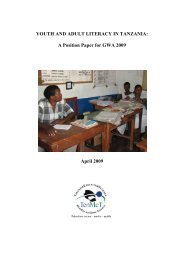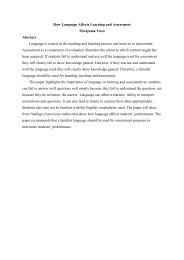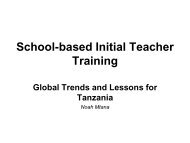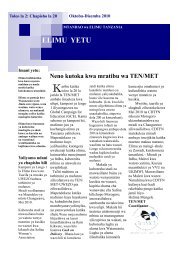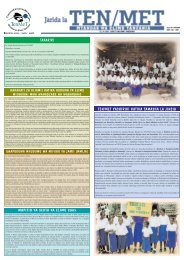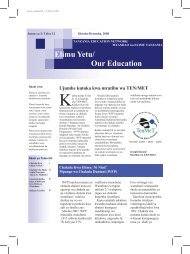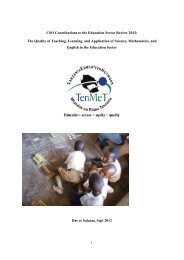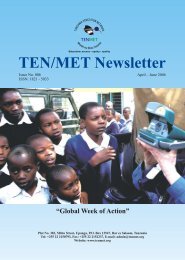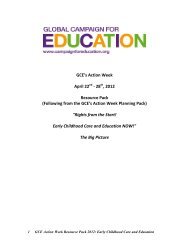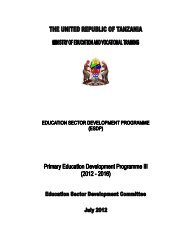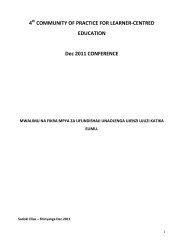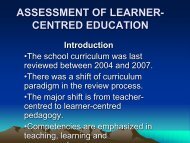Status of Children in Tanzania - 2012 - Tanzania Education Network ...
Status of Children in Tanzania - 2012 - Tanzania Education Network ...
Status of Children in Tanzania - 2012 - Tanzania Education Network ...
You also want an ePaper? Increase the reach of your titles
YUMPU automatically turns print PDFs into web optimized ePapers that Google loves.
Call for Action<br />
Table 8: Indicators on nutritional status<br />
Indicator def<strong>in</strong>ition <strong>Status</strong> 2004/05 <strong>Status</strong> 2009/10<br />
Proportion <strong>of</strong> under-fives moderately<br />
38% 42.3%<br />
underweight (weight for age)<br />
Proportion <strong>of</strong> under-fives severely underweight<br />
13% 16.6%<br />
(weight for age)<br />
Proportion <strong>of</strong> under-fives moderately stunted<br />
3% 4.6%<br />
(height for age)<br />
Proportion <strong>of</strong> under-fives severely stunted (height<br />
for age)<br />
< 1% 1.1%<br />
TDHS 2006 demonstrate that urban children enjoy better nutrition than rural areas. Statistically 26%<br />
<strong>of</strong> urban children under-five years <strong>of</strong> age are stunted as compared to 41% <strong>of</strong> rural children. NBS<br />
and Macro International 2006 revealed that nutrition rates are worst among the poor 50% <strong>of</strong><br />
children <strong>in</strong> the poorest 40% <strong>of</strong> household who are stunted compared to 23% <strong>of</strong> children from the<br />
least poor 20% <strong>of</strong> households.<br />
The rates <strong>of</strong> malnutrition <strong>in</strong> <strong>Tanzania</strong> vary widely across different geographical areas like L<strong>in</strong>di,<br />
Mtwara, Ruvuma, Rukwa, Kigoma, Ir<strong>in</strong>ga, Dodoma and Tanga the regions recorded 40% stunt<strong>in</strong>g<br />
children under five years. In those regions there has been <strong>in</strong>significant nutrition improvement. The<br />
pattern <strong>of</strong> malnutrition distribution <strong>in</strong> <strong>Tanzania</strong> <strong>in</strong>dicates that areas <strong>of</strong> the country which are the<br />
source <strong>of</strong> cereal surpluses e.g. <strong>in</strong> the South and West <strong>of</strong> <strong>Tanzania</strong> are also areas <strong>of</strong> high rates <strong>of</strong><br />
malnutrition. Food security therefore <strong>in</strong> the sense <strong>of</strong> cereal crop production does not seem to be<br />
associated with nutrition security. In some <strong>of</strong> the districts like Hai <strong>in</strong> Kilimanjaro and Serengeti <strong>in</strong><br />
Mara are districts which children were severely malnourished and special programme on nutrition<br />
had to be launched. That strategy <strong>in</strong>volved identify<strong>in</strong>g children who are <strong>in</strong> need <strong>of</strong> rehabilitation and<br />
support. There is a l<strong>in</strong>k between poor school achievement, repetition <strong>of</strong> grades and dropouts. It was<br />
revealed by respondents that lack <strong>of</strong> nutrition e.g. vitam<strong>in</strong> A, iod<strong>in</strong>e, salt limit the leaner not to be<br />
active <strong>in</strong> learn<strong>in</strong>g and th<strong>in</strong>k<strong>in</strong>g. Poverty lowers nutrition and children cannot get proper feed<strong>in</strong>g<br />
frequently per day. Experience from Mtwara, S<strong>in</strong>gida, L<strong>in</strong>di, Mara, Kigoma, Dodoma, Manyara and<br />
Ir<strong>in</strong>ga <strong>in</strong>dicates that under-two children do not get standard feed<strong>in</strong>g <strong>of</strong> 8 times a day.<br />
This challenge makes them to be deprived prote<strong>in</strong>, energy, vitam<strong>in</strong>s and iod<strong>in</strong>e which are important<br />
for bra<strong>in</strong> and cognitive growth and development. In Kilimanjaro, Manyara, Ir<strong>in</strong>ga and Mbeya there is<br />
low breast feed<strong>in</strong>g <strong>of</strong> children as lactat<strong>in</strong>g mother are fully <strong>in</strong>volved <strong>in</strong> farm<strong>in</strong>g activities. Thus<br />
<strong>in</strong>fants be<strong>in</strong>g left to sibl<strong>in</strong>g who do not know proper care <strong>of</strong> the young ones and feed<strong>in</strong>g practice.<br />
Thus frequent feed<strong>in</strong>g is very poor and low education on nutrition <strong>in</strong> the mentioned regions.<br />
In deed nutrition status <strong>of</strong> children at areas like L<strong>in</strong>di, Mtwara, Ir<strong>in</strong>ga, Dodoma, S<strong>in</strong>gida, Sh<strong>in</strong>yanga<br />
and Mbeya are critical and need <strong>in</strong>tervention as a right for children. There is a need to give more<br />
technical <strong>in</strong>formation on nutrition issues as an <strong>in</strong>tervention on its own right as well as improv<strong>in</strong>g<br />
childcare and encourag<strong>in</strong>g more frequent feed<strong>in</strong>g <strong>of</strong> children either through adults <strong>in</strong> the family,<br />
neighbours or establish<strong>in</strong>g childhood development centres, where all rights <strong>of</strong> children for survival<br />
and growth will be observed. Arguably there is a need to have special programmes to ensure that<br />
children get enough and balanced nutrition <strong>in</strong> areas like Iramba, Mtwara, L<strong>in</strong>di and Dodoma<br />
4.2.11 Food security and children rights<br />
<strong>Tanzania</strong> is one <strong>of</strong> the poorest country <strong>in</strong> the world, rank<strong>in</strong>g 151 st <strong>in</strong> the human development. Index<br />
score <strong>of</strong> 0.53 as per capital <strong>in</strong>come <strong>of</strong> USD 1,300 and 90% <strong>of</strong> the population liv<strong>in</strong>g <strong>in</strong> less than a<br />
dollar a day. The food security situation <strong>in</strong> <strong>Tanzania</strong> varies from one region to another and from<br />
season to another. There are some perennial pockets <strong>of</strong> food shortages particularly; Coast region,<br />
L<strong>in</strong>di, Mtwara, Tanga, Dodoma, S<strong>in</strong>gida, Mara, Kigoma and some areas <strong>of</strong> Morogoro region. The<br />
periodic production <strong>in</strong>crease for some regions is not stable and cannot be relied upon.<br />
Current food situation <strong>in</strong> <strong>Tanzania</strong> <strong>in</strong>dicates that some regions are highly food <strong>in</strong>secure. In these<br />
regions some families have serious problem and are food <strong>in</strong>secure. In 2010/2011 Arusha, Manyara,<br />
Dodoma, Kilimanjaro, Morogoro, Mtwara, Coast, Sh<strong>in</strong>yanga, and Tanga had some serious<br />
problems. Food <strong>in</strong>secure people were 717,684. (K<strong>in</strong>dly see Figure 13 which follows).<br />
25 / 55 <strong>Tanzania</strong>-CRSA-REPORT-<strong>2012</strong><br />
A lov<strong>in</strong>g home for every child




